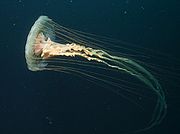
Soft-bodied organisms
Encyclopedia

Animal
Animals are a major group of multicellular, eukaryotic organisms of the kingdom Animalia or Metazoa. Their body plan eventually becomes fixed as they develop, although some undergo a process of metamorphosis later on in their life. Most animals are motile, meaning they can move spontaneously and...
s without skeleton
Skeleton
The skeleton is the body part that forms the supporting structure of an organism. There are two different skeletal types: the exoskeleton, which is the stable outer shell of an organism, and the endoskeleton, which forms the support structure inside the body.In a figurative sense, skeleton can...
, roughly corresponding to the group Vermes
Vermes
Vermes is an obsolete taxon used by Carolus Linnaeus and Jean-Baptiste Lamarck for all non-arthropod invertebrate animals. In Linnaeus system the group had the rank of class, occupying the 6th slot of his animal systematics...
as proposed by Carl von Linné. All animals have muscles, but since muscles can only pull, never push, a number of animals have developed hard parts that the muscles can pull on, commonly called skeletons. Such skeletons may be internal, as in vertebrates, or external, like in arthropods. However, a surprising number of animals groups do very well without hard parts. This include animals like earthworms, jellyfish
Jellyfish
Jellyfish are free-swimming members of the phylum Cnidaria. Medusa is another word for jellyfish, and refers to any free-swimming jellyfish stages in the phylum Cnidaria...
, tapeworms, squids and an enormous variety of animals from almost every part of the Animal Kingdom.
With few exceptions, soft-bodied animals are small. However, they do make up the majority of the animal biomass
Biomass
Biomass, as a renewable energy source, is biological material from living, or recently living organisms. As an energy source, biomass can either be used directly, or converted into other energy products such as biofuel....
. If we were to stuff all animals on Earth with hard parts in one pile and the soft-bodied ones in another, estimates indicate that the pile of soft-bodied animals would be at least twice the size of the other pile, quite possibly much larger.
The lack of hard parts in Soft-bodied organisms makes them extremely rare in the fossil record. Accordingly, the evolution
Evolution
Evolution is any change across successive generations in the heritable characteristics of biological populations. Evolutionary processes give rise to diversity at every level of biological organisation, including species, individual organisms and molecules such as DNA and proteins.Life on Earth...
ary history of many of the soft-bodied groups are poorly known. The first major find of fossil soft-bodied animals was from the Burgess Shale
Burgess Shale
The Burgess Shale Formation, located in the Canadian Rockies of British Columbia, is one of the world's most celebrated fossil fields, and the best of its kind. It is famous for the exceptional preservation of the soft parts of its fossils...
in Canada
Canada
Canada is a North American country consisting of ten provinces and three territories. Located in the northern part of the continent, it extends from the Atlantic Ocean in the east to the Pacific Ocean in the west, and northward into the Arctic Ocean...
. Today, several Burgess shale type fauna
Burgess shale type fauna
A number of assemblages bear fossil assemblages similar in character to that of the Burgess Shale. While many are also preserved in a similar fashion to the Burgess Shale, the term "Burgess Shale type fauna" covers assemblages based on taxonomic criteria only.-Extent:The fauna of the middle...
s are known, but the history of many groups of soft-bodied animals is still poorly understood.

